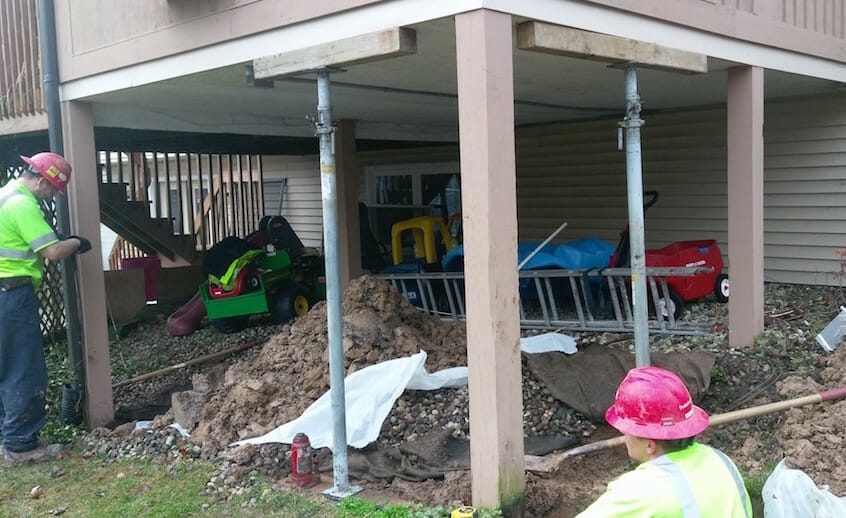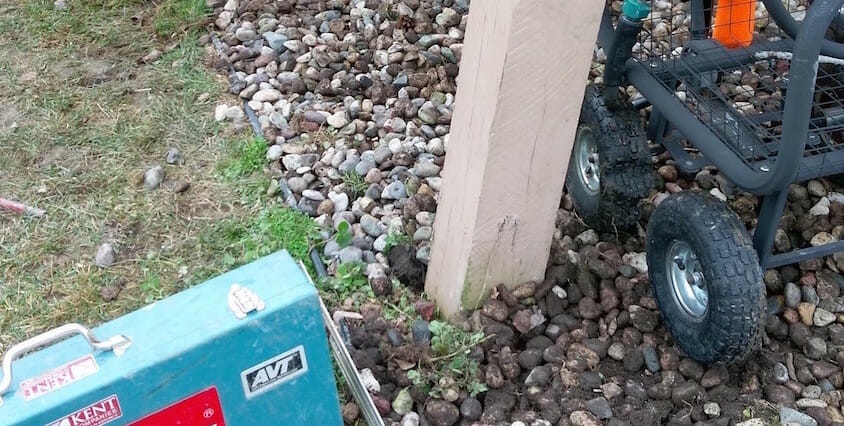Shawn and Katherine have been living in Westshore, Michigan for over 10 years. Their three season room had its deck and porch footings heave. The doors and windows were pushed up at an angle, and the locks on their double hung windows came off when the heaving forced the windows up at an angle. The winter humidity, rain, and snow over time had forced the frost deeper, causing the structure to settle at an angle overall. Along with soil erosion and deterioration over time because of the weather, Shawn and Katherine needed to remove their concrete pier footings and install a new helical piering system for their foundation.
Frost heave is a typical issue in the West Michigan regions. We’ve seen the effects of what poor soil conditions can do to ruin the comfort of a home sunroom. Deck and porch footings are shifted and made unstable because of the frost’s effect on water-bearing clay soils. Foundations sink and crack. Garage floors cave in because of poor compaction or breakdown of organics in the soil. We’ve seen beautiful wetland or lake lots sit vacant and unused because of poor soil conditions.
The problems aren’t new, but relatively speaking, many of the solutions available today are new or at least unfamiliar to most. One of the best solutions to stabilize your home sunroom is installing helical piers. Let’s take a look at some more information on the best practices for your foundation when you install helical piers.
KHS Installs Helical Piers For A Three Season Room in Grand Rapids
Here’s an image of one of our customers who installed helical piers beneath the foundation of their three season room. Helical pier anchors in Michigan support sinking or shifting foundations which have been weakened by harsh weather conditions. This can be applied to almost any permanent structure. Feel free to reach out to us if you would like us to check your home sunroom or room additions, or if you simply have questions.
You can see that two helical piers were installed under the two front posts outside the three season room. Helical piers were placed under the posts because the posts were beginning to sink deep into the soft soil underneath them. Helical piers were the only way to stabilize the job.
How Does Foundation Repair Work With Helical Piers?
Before we take a look at what some of the benefits of a helical piering system are, we’re going to talk about how a helical pier works for foundation repair. A helical pier is essentially a large screw that is dug deep into the ground until the proper torque force is met. This force is measured based on the soil condition. The force is met when it reaches a proper torque. The depth of the helical pier is penetrated varies based on soil conditions. Rotational resistance is measured when the pier is installed into the ground like a giant screw. Helical bearing plates are welded to a central shaft. The soil is dug out as the helical plates are dug into the sil. As a result the helical plates don’t auger into the soil but screw in with little disturbance. The first section is called the Lead Section. These contain the helical plates. The Lead Section contains one to four helices.
Based on the room addition, additional helical plates can be added with the use of Helical Extensions. Plain extensions are then added until the Lead Section penetrates the bearing strata and the necessary torque is achieved.
Weak or unstable soil close to the surface isn’t a problem because helical piers can be driven deeper to reach much stronger, stable soil. The screws make it possible for installations to be moved deeper. After the pier is installed, a square metal plate is welded at the top of the pier. Your structure sits on top of the metal plate.
Helical Piers vs. Concrete Piers
A foundation made of concrete piers is a typical installation that many people use for their home sunroom. Concrete pier foundations were once the standard practice for home sunrooms, porches, decks, and other similar structures. But this method has caused a number of different frustrations over the years. Let’s take a look at some of the reasons why concrete pier foundations may not be the best option for your deck room.
Bad Weather Can Cause Installation Delays
When you initially build a foundation with the concrete piers option, you have to factor in the weather. Concrete piers can’t be poured and holes can’t be dug during the rainy season or in the freezing cold weather.
Concrete Pier Foundations Have to be Installed with Precision
Post base hardware has to be carefully placed at the top of the concrete while it is still wet. The concrete has to harden before workers continue in their construction. If a concrete pier isn’t installed correctly, time and money is wasted to adjust the layout grid of the concrete.
Frost heave is a typical issue in the West Michigan regions. We’ve seen the effects of what poor soil conditions can do to ruin the comfort of a home sunroom.
Soil Erosion Causes Your Home Sunroom to Shift Over Time
You might find in your home sunroom or any other decks that soil expansion and contraction can cause shifting over time. This is because of hydrostatic pressure. Hydrostatic pressure is caused by the expansion and contraction of soil as water content flucuates from excessive water to drought conditions. Softer waterfront soil also can’t support the weight of your home sunroom or structure. With a concrete pier installation as a foundation, you can’t prevent this from happening. In fact, you have to be constantly monitoring this, which means more time and money is spent on maintaining this installation over time.
Difficult to Install After Room Additions Are Built
Concrete piers are much more difficult to install after the structure is built. Helical
piers make it possible for sunrooms to be stabilized even for existing structures. Simple machinery and installation procedures makes it easy for workers to install helical piers beneath pre-existing foundations.
Common Types of Structures Helical Piers Can Fix
Helical piers make a strong, fast foundation for decks, sunrooms and other small structures. Here is a list of structures that helical piers can be installed beneath.
- Room Additions
- Sunrooms
- Decks
- Porches
- Pavilions
- Sheds
- Storage buildings
- Cottages
- Mobile homes
- Elevated walkways
Benefits of Helical Piers for Home Sunroom or Room Additions
Using helical piers to stabilize your foundation is the best solution on the market. It’s easy for builders to install and is perfect for homeowners who are living in areas with soil erosion, bad weather, and other stabilizing issues that might affect their home sunroom. Let’s take a look at some of the specific reasons why you should consider installing a helical pier foundation.
Easier to Install Compared to Concrete Pier Foundations
Helical pier foundations are one of the best ways to avoid soil erosion issues, while also saving time and money in the long-run. They are also easy to install, especially in areas with limited access. Instead of having large trucks come to your home with concrete, the equipment is easy to mobilize and is lightweight.
Helical Pier Foundation Systems Can be Installed Any Time of the Year
A helical pier foundation system allows any homeowner to choose year-round installation. No matter the weather, rain or shine, helical foundation piers can be easily installed in any type of temperature. It is a little harder to install a helical pier foundation in extreme ground frost, but it’s much more possible compared to installing a concrete pier foundation.
Helical Piers Penetrate Deep Into the Soil Until it Reaches into the Bearing Strata
The installation is not only easier but it digs deeper into the soil to reach more competent, load bearing soils. These types of soils will keep your installation from being changed overtime. Helical pier footings are virtually guaranteed never to move. Even concrete installed properly and according to building codes can still move. Helical pier foundations are invulnerable to frost movement. The helical pier locks deep into good soil so that is well below frost depths. The smooth shafts keep the frost from heaving onto the soil.
Ready to be Used Immediately
The best part of installing helical piers is that there is no concrete to pour, and you don’t have to wait for the concrete to dry. When you’re digging holes, you have to go back and backfill if needed. But when you install helical pier foundation, it can be done immediately without any cure time. It requires far less digging or soil disposal compared to the traditional concrete footings.
Less Damage to Yards and Landscaping
There is no environmental impact that causes vibrations or disturbances to nearby structures when you install a helical pier foundation. Helical piers can be installed near existing foundations without any impact. These include foundations built on or near open water, bogs, and marshes. No harm is caused to wildlife or water quality.
The installation process involves small, non-invasive machinery, including light weight excavator that use load-distributing tracks instead of large, landscape-damaging truck tires. It takes one trip in and one trip out to install the helical pier. When you use a concrete pier, the heavy concrete truck has to back into the location of the footings, which leaves deep tire tracks in the lawn or leave trips on the lawn if hauled through the footings. With a helical pier there isn’t a mess like this. Your lawn will be free of damaging tire tracks.
When To Talk To A Professional
Installing a helical piering system can be expensive compared to a concrete pier foundation. Not really sure when you should consider installing a helical pier foundation? Here are some tips on when you should start talking to a professional about having your home sunroom checked out:
- If your sunroom is starting to shift, sag, settle or separate from your home.
- If the posts below your home’s sunroom, deck or elevated structure are deteriorated, bowed, or shifting off of their bases.
- If you’re considering building a home with a pre-existing sunroom.
Conclusion
We are only days away from the summer months, and you are likely planning your ultimate home repair project. Repairing your home sunroom foundation is a perfect place for you to enjoy the outdoors without the humidity, bugs, or dust on your feet. It’s the perfect place in your home to enjoy the outdoors rain or shine. One of the biggest things you can do to protect your investment before the summer begins is installing helical piers. Helical piers help stabilize your sunroom foundation, or any of your room additions, decks, and cottages to its original state. Helical piers will keep your home’s foundation from from sinking deep into the soil, keeping your sunroom solid and level.
Kent Foundation Repair specializes in installing helical pier foundation systems to restore your home’s sunroom to its original level state. Feel free to reach out to us for any questions!



